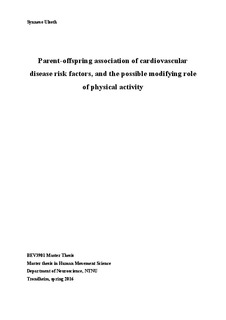| dc.description.abstract | Background: Cardiovascular disease (CVD) is one of the world’s major health issues, and
there is a worrying trend among young adults that show that the number of first time case
hospitalization due to acute myocardial infarctions, is increasing. It is known that some risk
factors for CVD are associated across generations. The current guidelines recommend that a positive parental history of CVD must be taken into consideration in the treatment and prevention of offspring CVD. Physical activity has been inversely associated with CVD, and studies have shown that physical activity is one of the most important modifiable factors that may contribute to a decrease in risk of developing CVD. The aim of the current study was to assess the possible parent-offspring associations in CVD risk factors, and to examine the possible modifying role of physical activity on the relationship of CVD risk factors between parents and their adult offspring.
Methods: The study was based on data from the two latest surveys from the Nord-Trøndelag Health Study (HUNT2 and HUNT3), where we investigated intergenerational associations of cardiovascular disease risk factor. Generalized linear regression was used to estimate adjusted mean differences in offspring level of body mass index (BMI), blood pressure, blood glucose and total cholesterol between the corresponding parental factors. Further, we used logistic regression to estimate odds ratios for unfavorable risk factor levels in the offspring related to parental risk factor levels. All associations were adjusted for parental age, BMI and levels of physical activity. Additionally, we examined the possible modifying role of offspring physical activity on the relationship of these risk factors in stratified analyses and by statistical test for interaction.
Results: There was a positive association between parents and offspring for all risk factors
studied. Further, the results showed that offspring were more likely to have high risk factor
levels if one of the parents had high levels, compared with normal level parents. Analyses
stratified by offspring activity levels (inactive vs active) gave no evidence of effect
modification, and this was supported by tests for statistical interaction between physical
activity and each of the risk factors (all p-values >0.05).
Conclusion: In this populations based family study we found a positive association between parent and offspring risk factors for CVD, pointing to the importance of genetic and shared family environment for CVD risk factor levels. Stratified analyses did not indicate that offspring level off physical activity had an effect modification. This indicates that offspring level of physical activity modified the observed parent-offspring association. | nb_NO |
